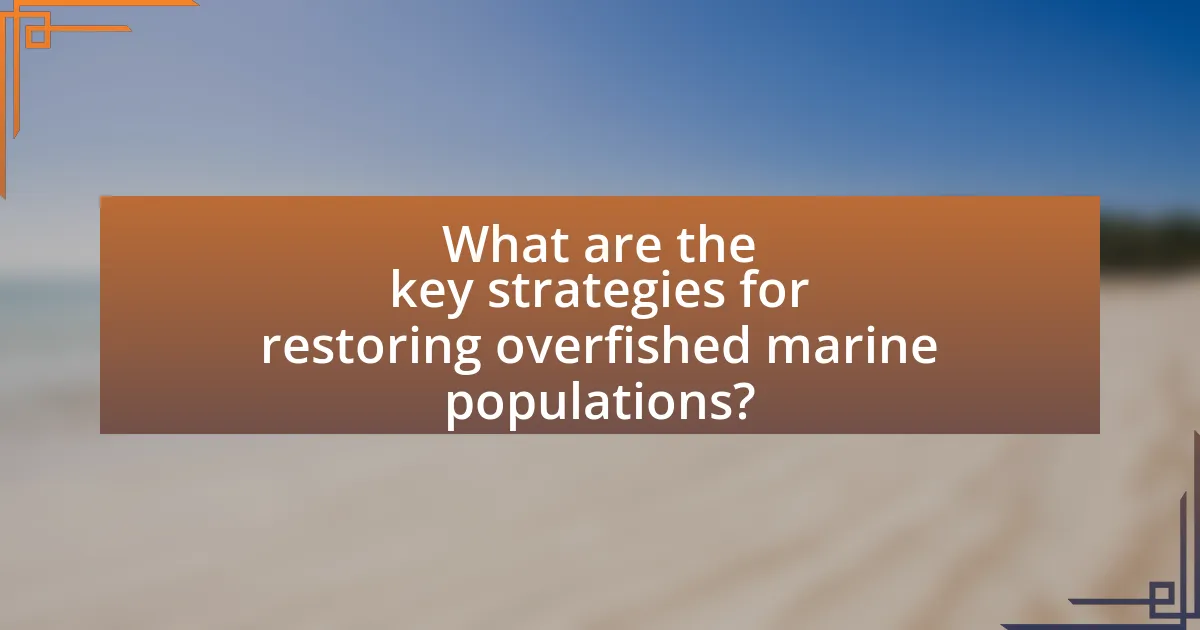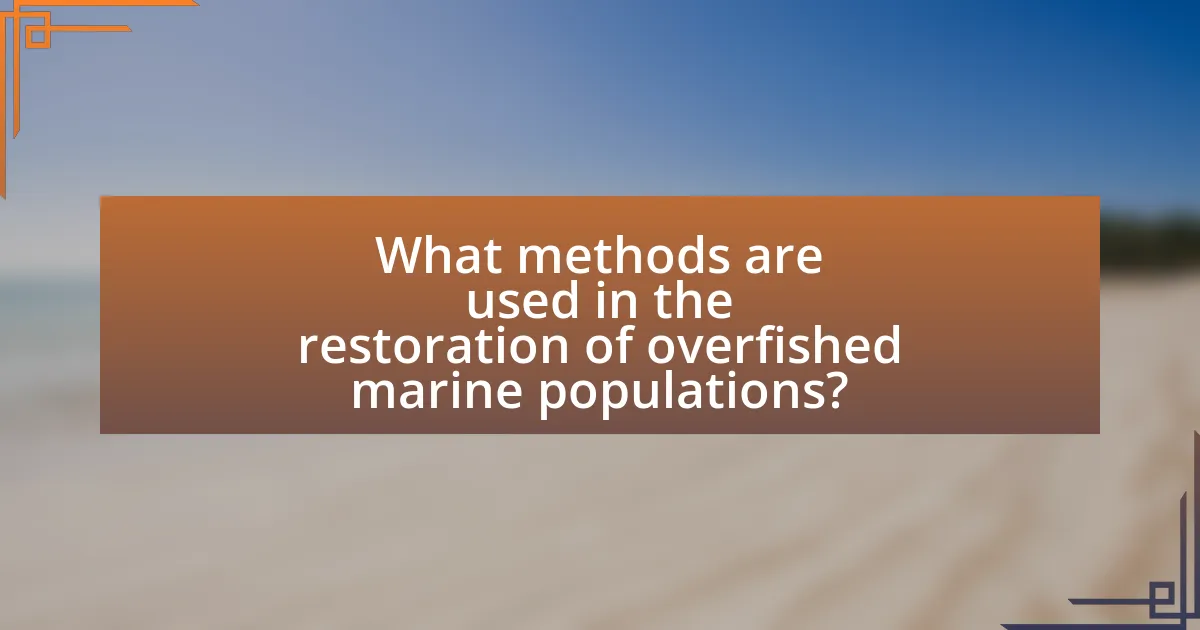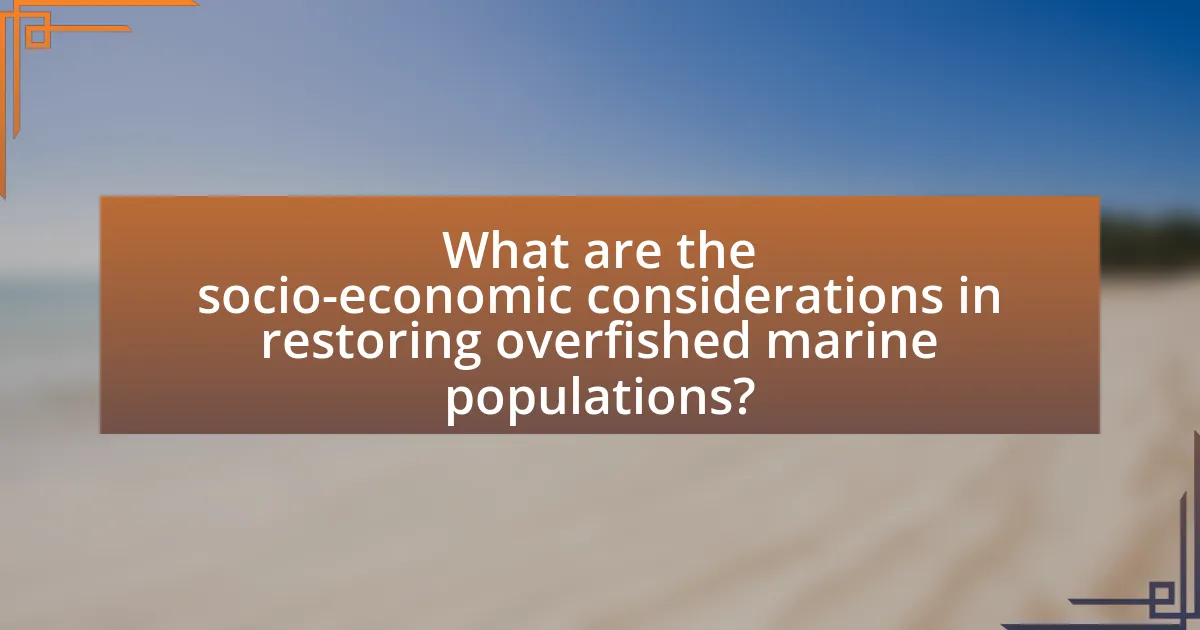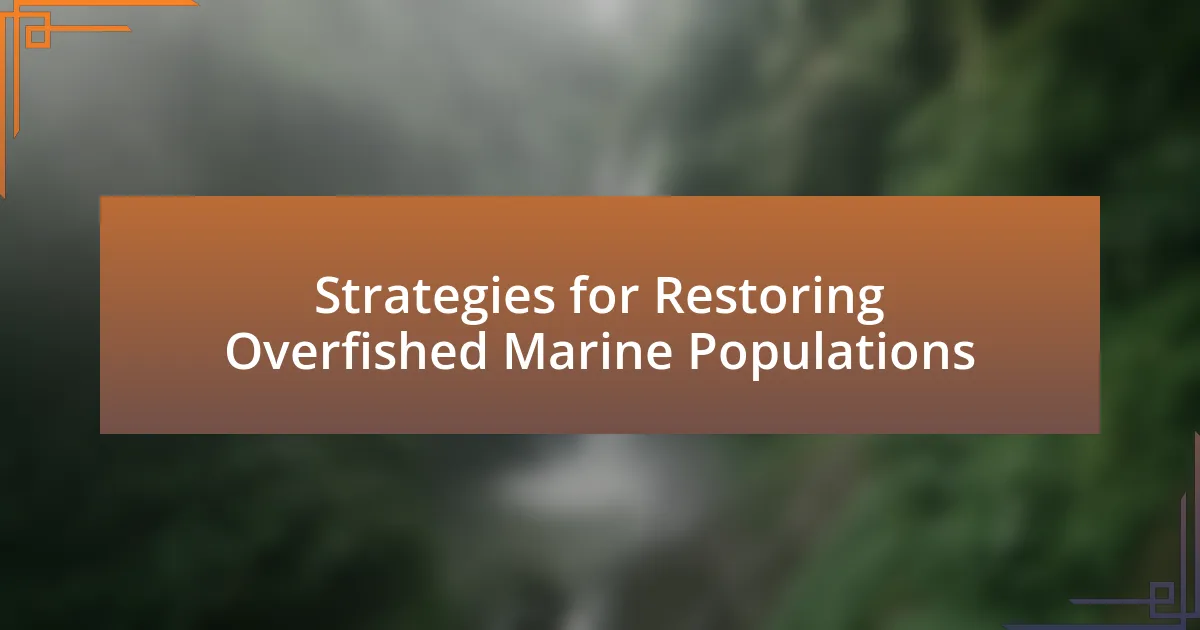The article focuses on strategies for restoring overfished marine populations, emphasizing sustainable fishing practices, marine protected areas (MPAs), and enhanced stock assessments. Key methods discussed include implementing catch limits, habitat restoration, and aquaculture, all aimed at reducing overfishing and promoting biodiversity. The article also explores the socio-economic implications of restoration efforts, highlighting the importance of community engagement, education, and economic incentives in achieving successful outcomes. Additionally, it addresses the ecological benefits of restoring fish populations and the role of monitoring and collaborative approaches in improving restoration strategies.

What are the key strategies for restoring overfished marine populations?
Key strategies for restoring overfished marine populations include implementing sustainable fishing practices, establishing marine protected areas (MPAs), and enhancing stock assessments. Sustainable fishing practices, such as catch limits and gear restrictions, help prevent overexploitation and allow fish populations to recover. Marine protected areas provide safe habitats where fish can breed and grow without fishing pressure, leading to increased biodiversity and population sizes. Enhanced stock assessments utilize scientific data to inform management decisions, ensuring that fishing quotas are based on accurate population estimates. These strategies have been shown to effectively restore fish populations, as evidenced by the recovery of species like the Atlantic cod in certain regions following the implementation of such measures.
How do these strategies address the causes of overfishing?
These strategies address the causes of overfishing by implementing sustainable fishing practices, establishing marine protected areas, and enforcing stricter regulations on catch limits. Sustainable fishing practices reduce the pressure on fish populations by promoting methods that minimize bycatch and habitat destruction. Marine protected areas serve as refuges for overfished species, allowing them to recover and reproduce without the threat of fishing. Stricter regulations on catch limits ensure that fish populations are harvested at sustainable levels, preventing depletion. For instance, the establishment of the U.S. Magnuson-Stevens Fishery Conservation and Management Act has led to the recovery of several fish stocks by enforcing science-based catch limits.
What role does sustainable fishing play in restoration efforts?
Sustainable fishing plays a crucial role in restoration efforts by ensuring that fish populations are harvested at a rate that allows them to replenish naturally. This approach helps maintain the balance of marine ecosystems, which is essential for the recovery of overfished species. For instance, studies have shown that implementing sustainable fishing practices can lead to a significant increase in fish biomass and biodiversity, as evidenced by the recovery of cod stocks in the North Atlantic following the establishment of catch limits and marine protected areas. By prioritizing sustainable methods, restoration efforts can effectively support the long-term health of marine populations and their habitats.
How can fishing quotas be effectively implemented?
Fishing quotas can be effectively implemented through a combination of scientific assessment, stakeholder engagement, and robust enforcement mechanisms. Scientific assessments provide data on fish populations, allowing for the establishment of sustainable catch limits based on species’ reproductive rates and ecosystem health. Engaging stakeholders, including fishermen and local communities, fosters compliance and ensures that quotas reflect the realities of fishing practices. Additionally, robust enforcement mechanisms, such as monitoring systems and penalties for violations, are essential to ensure adherence to quotas. For instance, the implementation of catch shares in various fisheries has shown to improve compliance and sustainability, as evidenced by the success of the U.S. West Coast groundfish fishery, which saw a significant recovery in fish stocks after quota systems were introduced.
What are the ecological impacts of restoring overfished populations?
Restoring overfished populations leads to increased biodiversity and ecosystem stability. When fish populations recover, they contribute to the balance of marine ecosystems by supporting predator-prey relationships and enhancing nutrient cycling. For instance, a study published in the journal “Nature” found that the recovery of cod populations in the North Atlantic resulted in a resurgence of various marine species, demonstrating the interconnectedness of marine life. Additionally, restored fish populations can improve the resilience of ecosystems against environmental changes, as diverse communities are better equipped to adapt to stressors.
How does biodiversity benefit from population restoration?
Biodiversity benefits from population restoration by enhancing ecosystem resilience and stability. When populations of overfished marine species are restored, they contribute to the overall health of marine ecosystems, which in turn supports a wider variety of species. For instance, a study published in the journal “Ecology Letters” found that restored fish populations can lead to increased species richness and abundance, as these populations play critical roles in food webs and nutrient cycling. This interconnectedness fosters a balanced ecosystem, allowing for greater biodiversity and improved ecological functions.
What are the potential risks of not restoring these populations?
The potential risks of not restoring overfished marine populations include ecosystem collapse, loss of biodiversity, and economic decline for communities reliant on fishing. Ecosystem collapse can occur as key species decline, disrupting food webs and leading to the dominance of less desirable species. For example, the collapse of cod stocks in the North Atlantic has resulted in significant ecological shifts. Loss of biodiversity diminishes resilience against environmental changes, making ecosystems more vulnerable to diseases and climate change. Economically, communities that depend on fishing face reduced catches and income, as seen in regions where fish populations have not been managed sustainably, leading to job losses and increased poverty.

What methods are used in the restoration of overfished marine populations?
Methods used in the restoration of overfished marine populations include the implementation of catch limits, habitat restoration, aquaculture, and the establishment of marine protected areas (MPAs). Catch limits regulate the amount of fish that can be harvested, allowing populations to recover; for example, the North Atlantic cod fishery has seen improvements due to strict quotas. Habitat restoration focuses on rebuilding critical ecosystems, such as coral reefs and seagrass beds, which support fish populations. Aquaculture provides an alternative source of seafood, reducing pressure on wild stocks; the global aquaculture production reached over 114 million tons in 2020. Lastly, MPAs protect essential habitats from fishing and other human activities, leading to increased biodiversity and fish biomass, as evidenced by studies showing that fish populations in MPAs can be up to five times larger than in unprotected areas.
How do marine protected areas contribute to population recovery?
Marine protected areas (MPAs) contribute to population recovery by providing a safe environment where marine species can thrive without the pressures of fishing and habitat destruction. These designated zones allow for the replenishment of fish stocks and the restoration of ecosystems, leading to increased biodiversity. Research indicates that fish populations within MPAs can grow significantly; for example, a study published in the journal “Nature” found that fish biomass in protected areas can increase by an average of 446% over time. This growth not only supports the recovery of individual species but also enhances the overall health of marine ecosystems, which is crucial for sustainable fisheries and biodiversity conservation.
What are the criteria for establishing effective marine protected areas?
Effective marine protected areas (MPAs) are established based on criteria that include ecological significance, representativeness, connectivity, and management effectiveness. Ecological significance ensures that areas protect critical habitats and biodiversity, while representativeness guarantees that various marine ecosystems are included. Connectivity refers to the need for MPAs to be linked to allow for species movement and genetic exchange. Management effectiveness involves having clear regulations, adequate resources, and stakeholder engagement to ensure the MPA’s goals are met. These criteria are supported by research indicating that well-designed MPAs can enhance fish populations and biodiversity, contributing to the recovery of overfished marine ecosystems.
How do marine protected areas affect local fishing communities?
Marine protected areas (MPAs) can significantly impact local fishing communities by restricting access to certain fishing grounds, which can lead to both positive and negative outcomes. On one hand, MPAs can enhance fish populations and biodiversity within their boundaries, resulting in spillover effects that benefit adjacent fishing areas. For example, a study published in the journal “Ecological Applications” found that fish biomass increased by an average of 446% in no-take zones, leading to improved catches for local fishers outside these areas. On the other hand, the establishment of MPAs may limit fishing opportunities for local communities, potentially leading to economic challenges and reduced livelihoods if alternative income sources are not developed. Thus, while MPAs can contribute to the long-term sustainability of fish stocks, their immediate effects on local fishing communities can vary based on management strategies and community engagement.
What role does aquaculture play in restoring overfished populations?
Aquaculture plays a crucial role in restoring overfished populations by providing a sustainable source of seafood that reduces pressure on wild stocks. By cultivating fish and shellfish in controlled environments, aquaculture helps to replenish depleted species and maintain biodiversity. For instance, the cultivation of species such as Atlantic salmon and Pacific oysters has been shown to alleviate the demand on their wild counterparts, allowing natural populations to recover. Additionally, aquaculture can contribute to habitat restoration efforts, as some practices involve the cultivation of species that enhance ecosystem health, such as filter-feeding bivalves that improve water quality. This dual benefit of providing alternative seafood sources while supporting ecological balance underscores aquaculture’s significance in the broader strategy of restoring overfished marine populations.
How can aquaculture practices be made sustainable?
Aquaculture practices can be made sustainable by implementing integrated multi-trophic aquaculture (IMTA), which combines different species to utilize waste and enhance ecosystem health. IMTA allows for the cultivation of finfish, shellfish, and seaweeds together, reducing environmental impacts and improving resource efficiency. Research indicates that IMTA can increase overall productivity by up to 30% while minimizing nutrient pollution, as demonstrated in studies conducted by the Food and Agriculture Organization (FAO). Additionally, adopting feed alternatives such as insect meal or plant-based proteins can reduce reliance on wild fish stocks for feed, further promoting sustainability in aquaculture.
What are the challenges associated with aquaculture in restoration efforts?
Aquaculture faces several challenges in restoration efforts, including environmental impacts, disease management, and genetic diversity concerns. Environmental impacts arise from nutrient pollution and habitat alteration, which can disrupt local ecosystems. Disease management is critical, as farmed species can transmit pathogens to wild populations, exacerbating existing health issues. Additionally, reliance on a limited number of species in aquaculture can reduce genetic diversity, making populations more vulnerable to diseases and environmental changes. These challenges complicate the effectiveness of aquaculture as a strategy for restoring overfished marine populations.

What are the socio-economic considerations in restoring overfished marine populations?
Restoring overfished marine populations involves critical socio-economic considerations such as the impact on local fishing communities, economic dependency on fisheries, and the need for sustainable management practices. Local fishing communities often rely on fish stocks for their livelihoods, making it essential to balance conservation efforts with economic stability. For instance, the decline of fish populations can lead to job losses and reduced income for fishermen, which can exacerbate poverty in coastal regions. Additionally, implementing sustainable fishing practices may require investment in new technologies and training, which can strain local economies. Research indicates that effective management strategies, such as establishing marine protected areas, can enhance fish populations while also providing long-term economic benefits, as seen in the case of the Great Barrier Reef, where tourism and fishing have thrived alongside conservation efforts.
How do community engagement and education impact restoration success?
Community engagement and education significantly enhance restoration success by fostering local stewardship and informed decision-making. Engaged communities are more likely to participate in restoration activities, leading to increased volunteerism and resource mobilization. For instance, a study published in the journal “Ecological Applications” found that projects involving local stakeholders had a 30% higher success rate in achieving ecological goals compared to those without community involvement. Education initiatives raise awareness about the importance of marine ecosystems, equipping individuals with the knowledge needed to support sustainable practices. This combination of engagement and education creates a sense of ownership and responsibility, which is crucial for the long-term sustainability of restoration efforts.
What strategies can be employed to involve local communities?
To involve local communities in restoring overfished marine populations, strategies such as participatory management, education and awareness programs, and economic incentives can be employed. Participatory management allows local stakeholders to have a voice in decision-making processes, fostering a sense of ownership and responsibility towards marine resources. Education and awareness programs inform communities about the importance of sustainable fishing practices and the ecological impacts of overfishing, which can lead to behavioral changes. Economic incentives, such as providing alternative livelihoods or financial support for sustainable practices, encourage community members to engage in conservation efforts. These strategies have been shown to enhance community involvement and improve the effectiveness of marine conservation initiatives, as evidenced by successful case studies in various regions where local engagement has led to the recovery of fish stocks and healthier marine ecosystems.
How does public awareness influence policy changes for restoration?
Public awareness significantly influences policy changes for restoration by mobilizing community support and driving political action. When the public is informed about the detrimental effects of overfishing and the importance of marine restoration, they are more likely to advocate for sustainable practices and policies. For instance, campaigns that raise awareness about the decline of fish populations can lead to increased public pressure on policymakers to implement regulations, such as fishing quotas or marine protected areas. Research shows that regions with higher public engagement in environmental issues often see more robust legislative responses aimed at restoration, as evidenced by the establishment of the Marine Protected Areas in the United States, which were largely driven by public advocacy and awareness efforts.
What economic incentives can support the restoration of overfished populations?
Economic incentives that can support the restoration of overfished populations include catch shares, subsidies for sustainable fishing practices, and investment in aquaculture. Catch shares allocate a specific portion of the total allowable catch to individual fishers or communities, promoting responsible fishing and reducing overexploitation. For example, the implementation of catch shares in the U.S. has led to increased fish stocks and economic benefits for fishers. Subsidies for sustainable practices encourage fishers to adopt methods that minimize environmental impact, such as selective fishing gear, which can enhance fish population recovery. Additionally, investing in aquaculture can alleviate pressure on wild fish stocks by providing alternative sources of seafood, as seen in countries like Norway, where aquaculture has significantly contributed to fish supply while allowing wild populations to recover.
How can governments and organizations fund restoration initiatives?
Governments and organizations can fund restoration initiatives through a combination of public funding, private investments, and international grants. Public funding often comes from government budgets allocated for environmental protection and restoration, which can be supported by legislation such as the U.S. National Oceanic and Atmospheric Administration’s (NOAA) funding for marine conservation projects. Private investments can be attracted through partnerships with businesses that benefit from healthy marine ecosystems, exemplified by corporate social responsibility initiatives. Additionally, international grants from entities like the Global Environment Facility provide financial resources specifically aimed at restoring overfished marine populations, as seen in various successful projects worldwide.
What role do eco-labeling and sustainable seafood markets play?
Eco-labeling and sustainable seafood markets play a crucial role in promoting responsible fishing practices and consumer awareness. These initiatives help to identify seafood products that are sourced from fisheries that adhere to sustainable practices, thereby reducing overfishing and supporting marine conservation. For instance, certifications like the Marine Stewardship Council (MSC) label indicate that the seafood has been harvested in a way that maintains fish populations and minimizes environmental impact. Research shows that eco-labeling can lead to increased sales of sustainable seafood, with a study indicating that products with eco-labels can see a price premium of up to 20%. This market-driven approach incentivizes fisheries to adopt sustainable practices, ultimately contributing to the restoration of overfished marine populations.
What best practices can be adopted for effective restoration of overfished marine populations?
Effective restoration of overfished marine populations can be achieved through the implementation of science-based fisheries management, habitat protection, and community engagement. Science-based fisheries management involves setting sustainable catch limits based on population assessments, which has been shown to lead to recovery in species such as the Atlantic cod, where strict quotas allowed populations to rebound. Habitat protection, including the establishment of marine protected areas (MPAs), helps safeguard critical breeding and feeding grounds, as evidenced by studies indicating that MPAs can increase fish biomass by up to 600%. Community engagement fosters local stewardship and compliance with regulations, enhancing the effectiveness of restoration efforts, as seen in successful initiatives in places like the Philippines, where local fishers actively participate in conservation measures.
How can monitoring and evaluation improve restoration strategies?
Monitoring and evaluation can significantly improve restoration strategies by providing data-driven insights that inform decision-making. These processes enable the assessment of the effectiveness of various restoration techniques, allowing for adjustments based on real-time feedback. For instance, studies have shown that adaptive management, which relies on continuous monitoring and evaluation, leads to more successful outcomes in marine restoration projects. A specific example is the implementation of catch limits and habitat protection measures in overfished areas, where ongoing assessments have demonstrated increased fish populations and biodiversity. By systematically analyzing the results of restoration efforts, stakeholders can refine strategies, allocate resources more effectively, and ultimately enhance the resilience of marine ecosystems.
What collaborative approaches can enhance restoration efforts?
Collaborative approaches that can enhance restoration efforts include stakeholder engagement, community-based management, and partnerships between governmental and non-governmental organizations. Stakeholder engagement ensures that local communities, fishers, and scientists work together to develop restoration strategies that are culturally and ecologically relevant. Community-based management empowers local populations to take charge of their resources, leading to more sustainable practices. Partnerships between governmental and non-governmental organizations facilitate the sharing of resources, expertise, and funding, which can significantly improve the effectiveness of restoration initiatives. For example, the collaboration between the Nature Conservancy and local fishing communities in the Gulf of California has led to successful marine protected areas that support fish population recovery.
